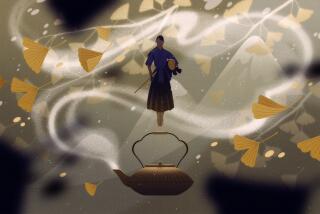In Mt. Fuji’s Shadow, Competition Blooms
- Share via
FUJINOMIYA, Japan — In the shadow of majestic Mt. Fuji, the tallest, most revered peak in Japan, Shinto priest Yasuhiko Kanemori ponders the plethora of religious groups that have sprouted around the mountain’s base like mushrooms.
It was bad enough that the fiery Nichiren Buddhist sect and its Soka Gakkai lay followers became embroiled in a veritable religious war here, spewing charges and countercharges of harassment, blasphemy and violence. Then the world watched aghast last year as a massive police raid on the Mt. Fuji headquarters of the Aum Supreme Truth cult uncovered a cache of illegal chemicals believed used for the group’s alleged nerve gas attack on Tokyo subways.
Now yet another controversial religious group in the area--Ho no Hana, or Flower of Law--has made headlines over charges that it bilked millions of dollars from more than 1,000 worshipers with suspect claims of miraculous health cures.
The group’s leader, Hogen Fukunaga, has curried ties with the likes of President Clinton--selling photos of the pair for $3 each at the group’s headquarters and, critics say, using them to lure more unsuspecting recruits.
The scandals are soiling the sacred image of Kanemori’s beloved mountain.
But the keeper of Fuji traditions and lore at Sengen Taisha--Japan’s oldest, most famous Shinto shrine dedicated to the mountain’s worship--is circumspect.
“If there are legal violations, they should be punished,” the old priest says of the other groups. “But I believe in freedom of religion. I am sure they all come to worship the mountain. We don’t have to fight each other.”
Kanemori says the mountain is big enough to accommodate all--and there are a lot.
Today, more than 1,600 officially registered religious organizations reside around Mt. Fuji, making the area a Japanese Jerusalem of sorts. Nestled in with new religious groups such as the apocalyptic Aum Supreme Truth and Flower of Law’s purported healers are ancient faiths such as Sengen Taisha’s Fuji worship, which dates back more than 2,000 years.
Worshipers flock to Fuji for its postcard-perfect conical shape, reputed mystical power and tranquil environment of clean air and healing hot springs. Others want to use the mountain’s mystique to attract followers--and donations, officials say.
“To be near Mt. Fuji gives you status, so there’s a trend for well-off religious organizations to want to establish their branches here,” said an official in Shizuoka, the prefecture, or state, that includes part of the mountain.
As in Hawaii, where the goddess Pele is said to reside in the Big Island’s tempestuous lava caldrons, Fuji lore revolves around a deity brought in to becalm the mountain’s terrible wrath.
Ancient Japanese documents tell of a fearsome Mt. Fuji eruption in the reign of the seventh emperor, Korei--about 2,300 years ago. It devastated the area “with fires leaping nearly to the heavens . . . and illuminating the clouds.”
About 260 years later, the 11th emperor, Suinin, decided to placate the mountain by honoring its sacred spirit, enshrining the Princess Konohana Sakuya Hime as chief goddess.
For centuries, mountain worship around Fuji and other sacred peaks in Japan was the province of ascetics known as yamabushi, whose spiritual training involved frugal vegetable diets, rigorous climbs and other physically taxing tasks.
But the practice opened up to the general public in the Edo period of the 17th century--and quickly became so widespread that the Tokugawa shogunate began feeling threatened, Kanemori said.
Fuji is still packed with climbers today--about 2 million reach the halfway point and 300,000 scale the summit each year.
Sengen Taisha boasts a bubbling pond fed by Fuji’s waters on its picturesque grounds of cherry trees, now ablaze in the vermilion leaves of autumn, and a 392-year-old shrine built by Japan’s legendary shogun Ieyasu Tokugawa and deemed a national cultural treasure.
Climbers have long stopped at the temple to cleanse their bodies and chant rokon shojo--purifying the “six paths” of sight, hearing, smell, taste, mind and body--before making the climb.
At the Flower of Law headquarters--a complex with glass chandeliers, marble bathrooms and the U.S. spacecraft Skylab 3 incongruously displayed on its grounds--attendants offer visitors sips of “Fuji Heavenly Water.”
Visitors may also purify their feet with the liquid, guided by a drawing of “energy centers” in the soles (a foot exam by group leader Fukunaga himself is said to cost almost $1,000).
The group’s literature says Fukunaga settled on the Fuji site after discovering a natural spring beneath a rock when he came here to climb the mountain at age 28. When he heard the “voice of heaven” telling him to establish a spiritual community, he returned to the same spot.
As lawyers move to lodge civil and criminal complaints against the group, authorities on Thursday rid the mountain of its most notorious religious organization.
Wearing the same riot gear they used in their first massive raid in 1995, police shut down Aum Supreme Truth’s facilities, expelled the last of the disciples and, on Friday, opened the onetime chemical complex to the public.
Still, some locals say the greatest threat to Fuji is not religious zealots, but tourists.
Japan’s most sacred mountain has increasingly become its biggest garbage pile, with tons of trash and waste slopped on its slopes each season. As a result, some environmentalists are calling for admission fees or limits on climbers.
Chiaki Kitada of The Times’ Tokyo Bureau contributed to this report.
More to Read
Sign up for Essential California
The most important California stories and recommendations in your inbox every morning.
You may occasionally receive promotional content from the Los Angeles Times.











